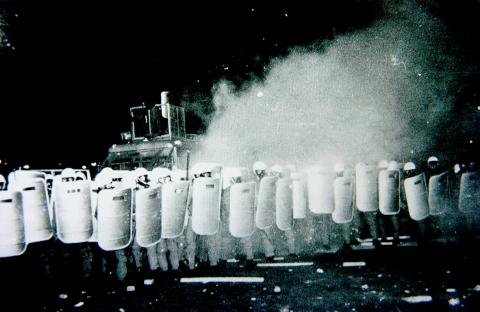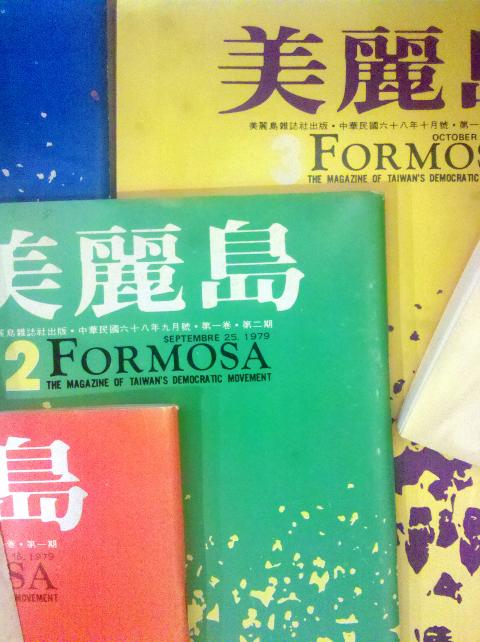Taiwan in Time: Dec. 7 to Dec. 13
The night of Dec. 12, 1979 was a restless one for the staff of Formosa Magazine (美麗島雜誌), as they gathered in a building in Taipei where several of them lived.

Photo: Chu Pei-hsiung, Taipei Times
Almost all of them would go on to become major Democratic Progressive Party (DPP) political players in the future, but for now, they were wanted criminals.
Two days previously, on Human Rights Day, the magazine, published by dangwai (黨外, “outside the party”) politicians opposing the Chinese Nationalist Party’s (KMT) one-party rule, organized a pro-democracy rally in Kaohsiung. The KMT sent troops and police to surround and intimidate the protesters, and things soon turned violent. Official injury numbers initially showed 183 officers and no civilians, the latter figure later increased to 50.
Accounts of what actually happened changed over time, with perceptions today being more sympathetic to the dangwai than what was indicated in the KMT-controlled media.

Courtesy of Wikimedia Commons
Today’s popular version of events is that the police repeatedly closed in on the protesters and used tear gas, which caused them to retaliate despite calls for calm by protest leaders. This came to be known as the Kaohsiung Incident, also called the Formosa Incident.
The next day, the National Security Bureau and Taiwan Garrison Command announced that they would arrest those who were responsible for the incident — namely the dangwai politicians.
In an oral history of the incident published by Academia Sinica, former vice president and Formosa Magazine editor Annette Lu (呂秀蓮) says for safety concerns she and current Kaohsiung mayor Chen Chu (陳菊) were staying with fellow magazine staff Lin Yi-hsiung (林義雄), Shih Ming-te (施明德) and Linda Gail Arrigo.
Lu says she fell asleep while Arrigo kept contact with the outside through telephone. When the phone line was cut, Arrigo knew something was wrong and barricaded the doors with furniture.
Lu remembers Chen jumping off the second floor balcony, distracting the officer pursuing Shih, who eventually got away. The rest of them were arrested. Arrigo was deported, while the others, along with four other opposition leaders were accused of sedition, tried by a military court and sentenced to terms ranging from 12 years to life imprisonment.
THEN AND NOW
Today, the incident is regarded as a crucial moment in Taiwan’s democratization. Though it would be another eight years until opposition parties were officially allowed, this event is often considered a sign of the KMT’s weakening grip on sole power of the country.
But back then, most media outlets portrayed the rally organizers as riot inciters who had planned the violence and were serious threats to a stable, “democratic” society.
Consider this passage from the 1980 book The Complete Story of the Formosa Incident (美麗島事件始末): “This is a very satirical tragedy in the history of Taiwanese democracy, as the violence was perpetrated by people who have been calling loudly for democracy.”
Almost each newspaper printed letters from “patriotic” readers denouncing the dangwai’s actions, as well as interviews with local officials, wounded officers, celebrities and so on. Most accounts also state that the officers didn’t fight back when attacked and praised their noble actions.
One article features an officer who lost several teeth in the incident. He reportedly refused the consolation money offered by the government.
Unable to speak, he wrote on a piece of paper, “What’s the use of giving me money? I just want our country to survive … I hope the government will stop tolerating these inhumane conspirators.”
Nothing could be more symbolic than the sailor who stood in the face of the protesters with his hands held high, tears on his face, singing loudly the patriotic song Plum Blossom (梅花), even continuing when he was attacked.
“I am Chinese, I love my country,” he reportedly yelled.
Of course, each side has their own story to tell, but the various commentaries calling the incident an attack on a “free and democratic” country is deeply ironic, as martial law was still in effect, and it was in fact the lack of democracy that led to the founding of the magazine.
Although opposition parties were still banned, the KMT appeared to become more lenient as it allowed dangwai politicians to run for the National Assembly in 1969. They were gearing up for the 1978 legislative elections when the US severed relations with Taiwan. In response, the KMT suspended all electoral activities and announced that emergency measures would be taken against those who gathered illegally or held demonstrations.
Their only means of entering politics cut off, the dangwai turned to political activism. Formosa was formed as the voice of the dangwai, and celebrated its first issue with a banquet at the Mandarina Crown Hotel while it was surrounded by taunting protesters led by members of a pro-KMT magazine. It was a rocky start, and it took a long time before things got easier.
Taiwan in Time, a column about Taiwan’s history that is published every Sunday, spotlights important or interesting events around the nation that have anniversaries this week.

Oct. 21 to Oct. 27 Sanbanqiao Cemetery (三板橋) was once reserved for prominent Japanese residents of Taipei, including former governor-general Motojiro Akashi, who died in Japan in 1919 but requested to be buried in Taiwan. Akashi may have reconsidered his decision if he had known that by the 1980s, his grave had been overrun by the city’s largest illegal settlement, which contained more than 1,000 households and a bustling market with around 170 stalls. Fans of Taiwan New Cinema would recognize the slum, as it was featured in several of director Wan Jen’s (萬仁) films about Taipei’s disadvantaged, including The Sandwich

“Wish You Luck is not just a culinary experience, it’s a continuation of our cultural tradition,” says James Vuong (王豪豐), owner of the Daan District (大安) Hong Kong diner. On every corner of Kowloon, diners pack shoulder-to-shoulder over strong brews of Hong-Kong-style milk tea, chowing down on French Toast and Cantonese noodles. Hong Kong’s ubiquitous diner-style teahouses, known as chachaanteng (茶餐廳), have been a cultural staple of the city since the 1950s. “They play an essential role in the daily lives of Hongkongers,” says Vuong. Wish You Luck (祝您行運) offers that same vibrant melting pot of culture and cuisine. In

Much noise has been made lately on X (Twitter), where posters both famed and not have contended that Taiwan is stupid for eliminating nuclear power, which, the comments imply, is necessary to provide the nation with power in the event of a blockade. This widely circulated claim, typically made by nuclear power proponents, is rank nonsense. In 2021, Ian Easton, an expert on Taiwan’s defenses and the plans of the People’s Liberation Army (PLA) to break them, discussed the targeting of nuclear power plants in wartime (“Ian Easton On Taiwan: Are Taiwan’s nuclear plants safe from Beijing?”, April 12, 2021). The

Artificial intelligence could help reduce some of the most contentious culture war divisions through a mediation process, researchers say. Experts say a system that can create group statements that reflect majority and minority views is able to help people find common ground. Chris Summerfield, a co-author of the research from the University of Oxford, who worked at Google DeepMind at the time the study was conducted, said the AI tool could have multiple purposes. “What I would like to see it used for is to give political leaders ... a better sense of what people ... really think,” he said, noting surveys gave